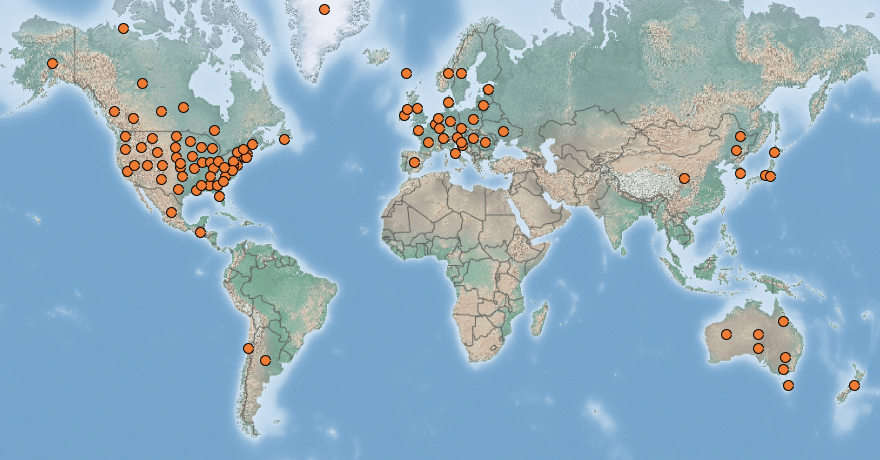 |
American willowherb | Status LU: established. 1st record: LU & ITW 1950 |
 |
Drüse-Weideréischen | Status Eur.: established. 1st record: UK 1891. |
 |
Épilobe à tige glanduleuse | RA: ISEIA: B3 – Watch List. Harmonia+: 0,15 |
 |
Drüsiges Weidenröschen | Wikipedia:    | Wikispecies: | Wikispecies:  | CABI | CABI |
 |
Beklierde basterdwederik | Back to the list of neophytes |
Contents
Report the species
→ Report Epilobium ciliatum to the National Museum of Natural History.
Brief description
Epilobium ciliatum Raf. is a pioneer plant species that thrives mainly in man-made environments such as arable land, gardens, tree nurseries, clearcuts and ruderal areas. It may also become established in open riparian habitats. Its seeds are adapted for wind dispersion and have a high germination rate. It is one of the arable weed species with the highest rate of increase in Europe (Branquart et al. 2010).
Status and distribution in Luxembourg
Records of Epilobium ciliatum Raf. in Luxembourg. Data source: Recorder-Lux, iNaturalist & GBIF, 2025-07-04.
Epilobium ciliatum Raf. was first documented under its synonym Epilobium adenocaulon Hausskn. on 1950-07-19 in wasteland on sand between two spruce stands near Croix-des-Bourgeois (Biergerkräiz) near Bridel (municipality of Kopstal) by François Léon Lefort (1917-1975) and Léopold Reichling (1921-2009) (Reichling 1961: 68ff.; MNHNL 2000-; herbarium specimen N°17920).
The species, described by Haussknecht in 1879 based on American herbarium samples, is native to North America where it is widely distributed as several varieties that are difficult to define. Introduction in Europe: < 1900 (Great Britain, Russia), 1900 (Sweden), 1915 (Netherlands), 1916 (Finland), 1931 (East Prussia), 1950 (Luxembourg), 1952 (Belgium, France) (Reichling 1961: 74).
This North American plant species was naturalised in Europe around 1900; it is rapidly expanding (Lambinon & Verloove 2012: 434).
700 records of the species are listed in the MNHNL-mdata online portal and the plant is widespread throughout the country (MNHNL, iNaturalist & GBIF 2019).
Risk assessment
ISEIA protocol
B3 (3+3+2+1) = Watch List (Ries et al. 2013: 18).
Harmonia+ protocol
Overall risk score 0,15 = (Overall Invasion score 0,69 x Overall Impact score 0,22) (Ries et al. 2020).
 Invasion
Invasion0,22

 Impact
Impact0,15

 Risk
RiskWorldwide distribution
Bibliography
- Branquart, E., S. Vanderhoeven, W. Van Landuyt, F. Van Rossum, F. Verloove, 2010. Harmonia database: Epilobium ciliatum Raf.. Harmonia version 1.2, Belgian Forum on Invasive Species. URL: http://ias.biodiversity.be [accessed on 2019-10-09]
- CABI, 2019. . In: Invasive Species Compendium. Wallingford, UK: CAB International. URL: www.cabi.org/isc [accessed 2020-02-28]
- Lambinon J. & F. Verloove, 2012. Nouvelle flore de la Belgique, du grand-duché de Luxembourg, du Nord de la France et des régions voisines. Sixième édition. Avec la collaboration de L. Delvosalle, B. Toussaint, D. Geerinck, I. Hoste, F. Van Rossum, B. Cornier, R. Schumacker, A. Vanderpoorten et H. Vannerom. Jardin botanique national de Belgique, Meise. CXXXIX + 1195 pp. ISBN : 9789072619884.
- MNHNL, 2000-. Epilobium ciliatum Raf. in Recorder-Lux, database on the natural heritage of the Grand Duchy of Luxembourg. Musée national d’histoire naturelle, Luxembourg. URL: https://mdata.mnhn.lu [Accessed 2019-10-09]
- MNHNL, iNaturalist & GBIF, 2019. Epilobium ciliatum Raf. in MNHNL-mdata, online portal combining species observation from Recorder-Lux, iNaturalist and GBIF. National Museum of Natural History, Luxembourg. URL: https://mdata.mnhn.lu [Accessed 2019-10-09]
- Reichling, L., 1961. Notes floristiques 1957-1958. Bull. Soc. Nat. luxemb. 63: 19-99. [PDF 4612 KB]
- Ries, C. & Y. Krippel, 2021. First records of 56 invasive alien vascular plants in Luxembourg. Bulletin de la Société des naturalistes luxembourgeois 123: 115-127. [PDF 241 KB]
- Ries, C., Y. Krippel & M. Pfeiffenschneider, 2020. Risk assessment after the Harmonia+ protocol of invasive alien vascular plant species in Luxembourg. Bull. Soc. Nat. luxemb. 122: 197-205. [PDF 132 KB]
- Ries, C., Y. Krippel, M. Pfeiffenschneider & S. Schneider, 2013. Environmental impact assessment and black, watch and alert list classification after the ISEIA Protocol of non-native vascular plant species in Luxembourg. Bull. Soc. Nat. luxemb. 114: 15-21. [PDF 652 KB]
Suggested citation of this webpage
Ries, C., M. Pfeiffenschneider & Y. Krippel (Eds.), 2025. Epilobium ciliatum Raf. In: neobiota.lu - Invasive Alien Species in Luxembourg. National Museum of Natural History, Luxembourg. URL: https://neobiota.lu/epilobium-ciliatum/ [Accessed 2025-07-04].
Page content last updated on 2021-03-03. Last proofread by Caroline Grounds on 2019-11-17.


